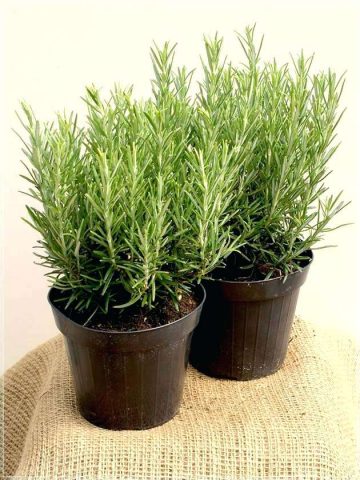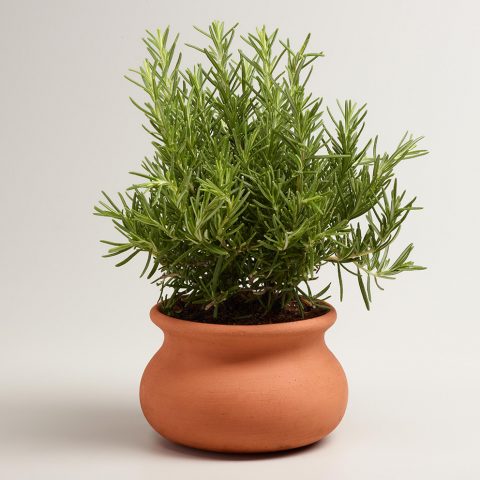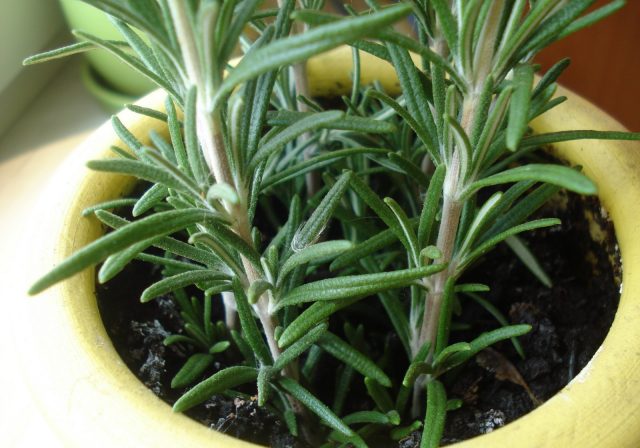Content
Growing rosemary at home in a pot is a multifunctional process. The exotic plant will decorate the interior, add to the collection of indoor flowers, it can be used as a seasoning for meat dishes, the plant has medicinal properties. In order for the rosemary to take root and not lose its decorative effect, it is necessary to properly plant the plant and create a favorable environment for the growing season.
Is it possible to grow rosemary at home
The homeland of rosemary is the Mediterranean, two types of culture grow in the wild - ordinary rosemary and prostrate. For home growing in an apartment, ordinary rosemary is suitable. A low-growing herbaceous shrub, thermophilic, does not tolerate low temperatures. A perennial will bloom at home only with sufficient light. These features are taken into account when determining the location.
The plant perceives high temperatures normally, it is recommended to take out rosemary in the summer to a balcony or veranda, it can be placed in an open area with periodic shading. Culture in winter at rest should be at home with an air temperature of +160C.
The best place for growing rosemary at home is on a windowsill on the south or east side. If this is not possible, the west or north will do, in this case it is necessary to create additional lighting. For the formation of healthy foliage, photosynthesis requires a significant amount of ultraviolet radiation.
Another condition for the normal cultivation of a culture at home is a sufficient supply of oxygen. In the warmer months, rosemary is placed near an open window. During flowering, the herbaceous shrub does not tolerate the change of night and day temperatures, so in the evening the window is closed. Care must be taken that the indoor flower is not in a draft.
Growing a herbaceous shrub on a site in the Russian climate is a rather laborious process. Rosemary with low frost resistance requires additional shelter in the fall to keep the roots from freezing. Even protection from frost does not guarantee that the culture will not die. Therefore, the best option is to grow rosemary at home on a windowsill.
Methods for growing rosemary at home on a windowsill
At home, growing a shrub is possible in several ways:
- cuttings;
- seeds;
- branches or tops of shoots.
Planting material is purchased in specialized stores or seedlings are obtained independently from seeds. The optimal and effective option for home breeding is by cuttings. Growing rosemary at home from seeds is a long process, the planting material does not always sprout. If the young shoots have sprouted together, some of the shoots may die due to improper care:
- unsuitable soil composition;
- excessive watering;
- moisture deficiency;
- low temperature in the house.
How to plant rosemary at home
In order to plant a culture, seedlings are pre-prepared. Instructions on how to grow rosemary from seeds at home:
- For 48 hours before placing in the soil, the seeds are soaked in a manganese solution, then gently laid out on a damp cloth.
- A prerequisite for germination at home is that the tissue and seeds must be constantly moist.
- After 4 days, sprouts will appear, the material is ready for growing seedlings.
- The seeds are deepened into the soil by 1 cm.
- Cover the top with a film, make holes for air intake.
- They are removed to a room with a constant temperature of +200 C.
- Moisten every day with a spray bottle.
Seedlings for the further cultivation of rosemary at home are sown in February. After about 21 days, the seeds will sprout.
Rosemary is grown at home from cuttings in the following way:
- cut off last year's branch;
- leaves are removed from the bottom;
- make an oblique cut, place in wet sand or in a glass of water;
- the sand is constantly moistened.
The stalk will give roots, it can be planted.
For home growing by layering:
- in the spring, tilt the lower branch to the ground;
- fix with staples;
- cover with soil from above.
By autumn, the cuttings will take root, next spring they will be ready for transplanting. The method of home cultivation of rosemary with the tops of the shoots is rarely used, it is less effective.
Landing dates
The planting time for growing rosemary at home is determined by the readiness of the planting material. Seedlings are suitable for planting when they reach 10 cm in height. The cuttings should give a sufficient number of root shoots for home cultivation, and the cuttings should take root. As a rule, work at home is carried out from spring to mid-summer. In autumn, the plant is not planted, the culture slows down the growing season by winter, there is no guarantee that the seedling will take root.
Preparation of containers and soil
The root system of rosemary is branched, shallow. A young seedling forms a root for the first year at home, then the crown begins to grow. A container for rosemary is chosen with an average height of about 20 cm, always wide. For the first year, the seedling can be placed for home growing in a container 10 cm wider than the root system. A year later, the rosemary needs a transplant, a permanent pot is chosen with the same condition, it should be 15 cm wider than the root. For better oxygen enrichment, preference is given to natural material: wood, clay. At the bottom of the container, a drainage hole is required.
Before planting, the pot is treated with boiling water. A nutritional mixture is prepared, consisting of the ratio of parts:
- sod layer - 2;
- coarse sand - 1;
- organic - 1;
- peat - 2.
Planting soil can be purchased at the store.
How to plant correctly
If the planting of rosemary at home is carried out with seeds, the seedlings are planted from a common container when they grow up to 10 cm.For each seedling, a separate pot is determined, together they will not be able to fully develop due to the branched root system, one plant will displace the other.
In the case of breeding at home by layering, the rooted branch is cut off from the mother bush, carefully, transferred to the pot with the soil, the top is cut off. A cuttings with a well-grown root system when transplanted into a pot are also cut off the upper part. This measure is necessary for the formation of lateral processes. Less commonly, a culture is grown at home with the tip of an annual shoot. Cut by about 6 cm and immediately placed in the ground, the survival rate of rosemary is within 45%.
Landing Algorithm:
- A drainage layer is placed on the bottom of the pot: expanded clay, small pebbles or gravel.
- Above - coarse sand.
- Divide the mixture into 2 parts, pour ½ of the total mass into a pot.
- A depression is made along the width of the root.
- The plant is placed vertically, the roots are taken apart so that they do not intertwine.
- The remaining soil is added, compacted, watered.
A polyethylene dome with perforated holes is installed on top. Put away in a warm, bright place. A week later, the shelter is removed, if the plant has taken up at home, it no longer needs the greenhouse effect.
How to care for potted rosemary at home
Rosemary cannot be called an unpretentious plant, it requires certain criteria for home cultivation. If the bush begins to bloom, this is the first sign that all the rules for growing have been followed.
Microclimate creation
In the summer, rosemary is in the growing season, the optimum temperature for the formation of leaves and flowers is + 25 ... +280 C. Caring for rosemary at home in winter, when the plant has stopped growing, provides for a decrease in temperature to +150 C. It is not easy to create the necessary microclimate at home. To reduce the temperature regime, the flower is placed on the windowsill closer to the glass and away from the heating devices. For cooling, a container with ice or snow is placed near the pots.
Humidity for home growing in the winter season is a necessary indicator. Central heating makes the air very dry. The bush begins to ache, the crown loses its decorative effect. To increase the humidity, the plant is sprayed, placed in a tray with expanded clay or pebbles, and water is poured.
Waterlogging can provoke root decay and the death of a shrub. If installed correctly, the water evaporates and creates the necessary moisture around the rosemary.
If, when grown at home for the summer, rosemary is taken out to the site, periodic shading is normal. In the room, the herbaceous shrub should not be in the shade. Lighting is required for home cultivation for at least 8 hours a day. If necessary, install fluorescent lamps, they can be left on overnight, rosemary responds well to daily lighting. In order for the crown to develop evenly at home, the pots are turned once every 5 days with the side opposite to the window.
How to water rosemary in pots
Watering rosemary is required in the same way as for all biological species. Here you need to decide on the regime. Too waterlogged soil is destructive for a shrub, and a lack of moisture slows down the growing season. Constantly moist soil at home does not allow air to pass through well, and the rosemary root system is demanding for a sufficient supply of oxygen. If after watering in a pan for 30 minutes. there is water, the procedure is too frequent and the amount of moisture is abundant. Watering should be reduced in frequency and volume.
Rosemary, when grown at home, does better if the topsoil dries up between waterings. The irrigation regime depends on the location of the crop. Outdoors, daily spraying in the morning and evening and one watering every 10 days is sufficient. If at home there is a rosemary in a pot on the window, maintenance becomes more difficult. It is undesirable to spray the plant; with poor air circulation, a fungal infection can develop. To determine the frequency of soil moisture at home, flower growers use the following method. After the procedure, do not water the rosemary until the leaves begin to wither. Calculate the time and subtract 2 days. In winter, watering at home is reduced to a minimum - once a month will be enough.
Why does rosemary dry in a pot
A shrub when grown at home can stop growing and begin to dry out for several reasons:
- lack of moisture - it is necessary to increase watering;
- poor air ventilation - the room must be ventilated;
- the pot for the plant is too cramped - transplanting into a large container is required;
- waterlogging of the soil - the root system rots. The plant is dug up, the roots are washed, the missing fragments are removed, the soil is changed, watering is reduced.
In winter, the shrub dries at home at high temperatures and low air humidity, these problems must be eliminated.
Feeding schedule
To care for rosemary at home, be sure to include plant nutrition. The volume of soil in the pot is small, the root system intensively absorbs nutrients, the soil is depleted. For full-fledged cultivation at home, it is impossible to feed the culture throughout the year in a row, an excess of trace elements can have the opposite effect - rosemary loses its decorative effect, stops growing and does not bloom. Feeding Schedule for Home Growing:
- in the spring, nitrogen fertilizers are dissolved, applied together with watering for 3 weeks;
- in the summer at home, 2 weeks are fertilized with phosphorus, a solution under the root, along with watering;
- then give potassium according to the same scheme;
- in the fall, granules with microelements are laid in the ground, they are purchased in the store, the composition is selected taking into account the fact that home cultivation on acidic soils is undesirable.
In winter, when the bush is at rest, no fertilizer is applied.
When to cut rosemary
Growing at home requires the formation of a crown. The first pruning of rosemary is carried out when the bush grows to 20 cm.During this time, the central branches become tough, stiff. Young shoots are cut in the spring, after flowering. Thus, a crown is formed, the trimmed shoots are used in cooking. The culture retains the qualities of a spicy seasoning if the shoots are dried in a shaded, well-ventilated place. In the fall, pruning is not carried out at home.
Conclusion
Growing rosemary at home in a pot, subject to the conditions for care, is not difficult. Mandatory requirement: compliance with the temperature regime, a sufficient amount of ultraviolet radiation, fresh air and the frequency of dressings. A plant with a decorative crown and bright purple flowers will be a worthy decoration for your home interior and will complement your diet with spicy seasoning.












